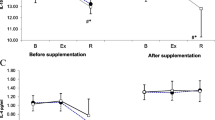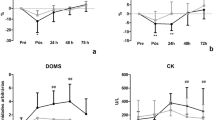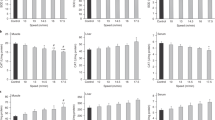Abstract
Exercise intensity usually correlates with increased oxidative stress and enhanced cytokine production. However, it is unknown if all types of exercise that induce muscle damage can cause a parallel response in the oxidation balance and cytokine production. To this end, the effect of a 2000-m running test in a group of volunteers that regularly train in aerobic routines was studied. Different circulating parameters were measured, oxidative stress markers (protein carbonyls and malondialdehyde), antioxidant enzyme activity, and cytokine levels in plasma as well as in the main circulating cells of blood samples obtained in basal conditions and after test execution. As a result, the test caused muscle damage evidenced by an increase in circulating creatine kinase and myoglobin. This was accompanied by an increase in protein carbonyls in plasma and peripheral blood mononuclear cells. Activities of antioxidant enzymes (catalase, glutathione peroxidase and reductase, superoxide dismutase) were elevated in peripheral blood mononuclear cells, neutrophils, and erythrocytes after the test. Regarding cytokine production, interleukin-6, interleukin-8, interleukin-10, and tumor necrosis factor-α exhibited no significant changes after the test. Results suggest that this short but intense running exercise (2000 m) can induce muscle damage and elicit a good balance between oxidant/antioxidant responses with no changes in the circulating concentration of pro-inflammatory cytokines.
Similar content being viewed by others
References
Aguiló A, Monjo M, Moreno C, Martinez P, Martinez S, Tauler P (2014) Vitamin C supplementation does not influence plasma and blood mononuclear cell IL-6 and IL-10 levels after exercise. J Sports Sci 32:1659–1669
Azizbeigi K, Azarbayjani MA, Atashak S, Stannard SR (2015) Effect of moderate and high resistance training intensity on indices of inflammatory and oxidative stress. Res Sports Med 23:73–87
Bloomer RJ (2008) Effect of exercise on oxidative stress biomarkers. Adv Clin Chem 46:1–49
Bloomer RJ, Fry AC, Falvo MJ, Moore CA (2007) Protein carbonyls are acutely elevated following single set anaerobic exercise in resistance trained men. J Sci Med Sport 10:411–417
Bruunsgaard H, Galbo H, Halkjaer-Kristensen J, Johansen TL, MacLean DA, Pedersen BK (1997) Exercise-induced increase in serum interleukin-6 in humans is related to muscle damage. J Physiol 499:833–841
Carrera-Quintanar L, Funes L, Vicente-Salar N, Blasco-Lafarga C, Pons A, Micol V, Roche E (2015) Effect of polyphenol supplements on redox status of blood cells: a randomized controlled exercise training trial. Eur J Nutr 54:1081–1093
Croisier JL, Camus G, Venneman I, Deby-Dupont G, Juchmes-Ferir A, Lamy M, Crielaard JM, Deby C, Duchateau J (1999) Effects of training on exercise-induced muscle damage and interleukin 6 production. Muscle Nerve 22:208–212
Della Gatta PA, Garnham AP, Peake JM, Cameron-Smith D (2014) Effect of exercise training on skeletal muscle cytokine expression in the elderly. Brain Behav Immun 39:80–86
Febbraio MA, Steensberg A, Keller C, Starkie RL, Nielsen HB, Krustrup P, Ott P, Secher NH, Pedersen BK (2003) Glucose ingestion attenuates interleukin-6 release from contracting skeletal muscle in humans. J Physiol 549:607–612
Fischer CP, Hiscock NJ, Penkowa M, Basu S, Vessby B, Kallner A, Sjöberg LB, Pedersen BK (2004) Supplementation with vitamins C and E inhibits the release of interleukin-6 from contracting human skeletal muscle. J Physiol 558:633–645
Geering B, Simon HU (2011) Peculiarities of cell death mechanisms in neutrophils. Cell Death and Differ 18:1457–1469
Groussard C, Rannou-Bekono F, Machefer G, Chevanne M, Vincent S, Sergent O, Cillard J, Gratas-Delamarche A (2003) Changes in blood lipid peroxidation markers and antioxidants after a single sprint anaerobic exercise. Eur J Appl Physiol 89:14–20
Higashida K, Kim SH, Higuchi M, Holloszy JO, Han DH (2011) Normal adaptations to exercise despite protection against oxidative stress. Am J Physiol Endocrinol Metab 301:E779–E784
Hotamisligil GS (2006) Inflammation and metabolic disorders. Nature 444:860–867
Marfell-Jones M, Olds T, Steward A, Carter L (2006) International standards for anthropometric assessment. International Society for the Advancement of Kinanthropometry, Potchesfstroom
McGinley C, Shafat A, Donnelly AE (2009) Does antioxidant vitamin supplementation protect against muscle damage? Sports Med 39:1011–1032
Morton JP, Kayani AC, McArdle A, Drust B (2009) The exercise-induced stress response of skeletal muscle, with specific emphasis on humans. Sports Med 39:643–662
Moylan JS, Reid MB (2007) Oxidative stress, chronic disease, and muscle wasting. Muscle Nerve 35:411–429
Nimmo MA, Leggate M, Viana JL, King JA (2013) The effect of physical activity on mediators of inflammation. Diab Obes Metab 15:51–60
Ortega E (2016) The “bioregulatory effect of exercise” on the innate/inflammatory responses. J Physiol Biochem 72:361–369
Peake JM, Nosaka K, Muthalib M, Suzuki K (2006) Systemic inflammatory responses to maximal versus submaximal lengthening contractions of the elbow flexors. Exerc Immunol Rev 12:72–85
Peake JM, Suzuki K, Hordern M, Wilson G, Nosaka K, Coombes JS (2005a) Plasma cytokine changes in relation to exercise intensity and muscle damage. Eur J Appl Physiol 95:514–521
Peake JM, Suzuki K, Wilson G, Hordern M, Nosaka K, Mackinnon L, Coombes JS (2005) Exercise-induced muscle damage, plasma cytokines, and markers of neutrophil activation. Med Sci Sports Exerc 37:737–745
Petersen EW, Ostrowski K, Ibfelt T, Richelle M, Offord E, Halkjaer-Kristensen J, Pedersen BK (2001) Effect of vitamin supplementation on cytokine response and on muscle damage after strenuous exercise. Am J Physiol Cell Physiol 280:C1570–C1575
Scheele C, Nielsen S, Pedersen BK (2009) ROS and myokines promote muscle adaptation to exercise. Trends Endocrinol Metab 20:95–99
Schiffl C, Zieres C, Zankl H (1997) Exhaustive physical exercise increases frequency of micronuclei. Mut Res 389:243–246
Smith C, Kruger MJ, Smith RM, Myburgh KH (2008) The inflammatory response to skeletal muscle injury: illuminating complexities. Sports Med 38:947–969
Smith LL, McKune AJ, Semple SJ, Sibanda E, Steel H, Anderson R (2007) Changes in serum cytokines after repeated bouts of downhill running. Appl Physiol Nut Metab 32:233–240
Steensberg A, Keller C, Hillig T, Frөsig C, Wojtaszewski JF, Pedersen BK, Pilegaard H, Sander M (2007) Nitric oxide production is a proximal signaling event controlling exercise-induced mRNA expression in human skeletal muscle. FASEB J 21:2683–2694
Steinberg JG, Ba A, Bregeon F, Delliaux S, Jammes Y (2007) Cytokine and oxidative responses to maximal cycling exercise in sedentary subjects. Med Sci Sports Exerc 39:964–968
Toft AD, Jensen LB, Bruunsgaard H, Ibfelt T, Halkjaer-Kristensen J, Febbraio M, Pedersen BK (2002) Cytokine response to eccentric exercise in young and elderly humans. Am J Physiol Cell Physiol 283:C289–C295
Uchida MC, Nosaka K, Ugrinowitsch C, Yamashita A, Martins E Jr, Moriscot AS, Aoki MS (2009) Effect of bench press exercise intensity on muscle soreness and inflammatory mediators. J Sports Sci 27:499–507
Vassilakopoulos T, Karatza M-H, Katsaounou P, Kollintza A, Zakynthinos S, Roussos C (2003) Antioxidants attenuate the plasma cytokine response to exercise in humans. J Appl Physiol 94:1025–1032
Wadley AJ, Chen YW, Lip GY, Fisher JP, Aldred S (2015) Low volume-high intensity interval exercise elicits antioxidant and anti-inflammatory effects in humans. J Sports Sci 34:1–9
Willoughby DS, McFarlin B, Bois C (2003) Interleukin-6 expression after repeated bouts of eccentric exercise. Int J Sports Med 24:15–21
Acknowledgements
We thank Jose Maria Adsuar for his technical assistance in blood analysis. AP, VM, and ER are members of CIBERobn (Fisiopatología de la Obesidad y la Nutrición CB12/03/30038) Instituto de Salud Carlos III, Spain. LC-Q and LF were recipients of CONACYT-Mexico (ref 197139) and FPI (Spanish Science Ministry) fellowships respectively. This work was supported by Generalitat Valenciana under the PROMETEO grant 2012/007 to VM and ER.
Author information
Authors and Affiliations
Corresponding author
Ethics declarations
The protocol was in accordance with local legal requirements and the Helsinki Declaration for research on human beings and approved by the Ethics Committee of the corresponding Autonomic Governments with reference IB 544/05 PI.
Conflict of interest
The authors declare that they have no conflict of interest.
Rights and permissions
About this article
Cite this article
Carrera-Quintanar, L., Funes, L., Sánchez-Martos, M. et al. Effect of a 2000-m running test on antioxidant and cytokine response in plasma and circulating cells. J Physiol Biochem 73, 523–530 (2017). https://doi.org/10.1007/s13105-017-0575-z
Received:
Accepted:
Published:
Issue Date:
DOI: https://doi.org/10.1007/s13105-017-0575-z




